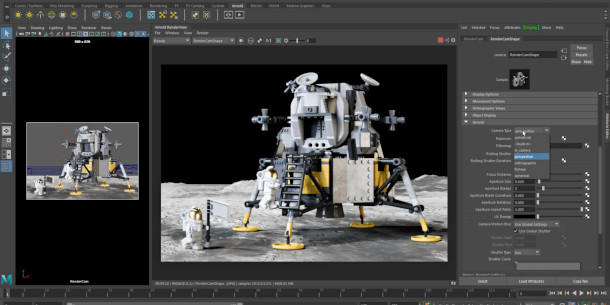Autodesk ships Arnold 6.0
Autodesk has released Arnold 6.0, the latest version of the VFX-industry-standard production renderer, officially moving Arnold GPU, its much-anticipated new GPU rendering system, out of beta.
The update also adds dielectric microfacet multiple scattering, plus improvements to creased subdivisions, the Physical Sky and Standard Surface shaders, and more accurate albedo AOVs.
Outside the core application, Autodesk has released a set of new tools and add-ons for using Arnold in a USD-based pipeline, including a new Hydra render delegate.
The firm has also introduced new lower-cost single-user subscriptions for solo artists and small studios.
The update shipped earlier this week, alongside Maya 2020 and Maya LT 2020.
Arnold GPU: now officially ready for use in production
The headline change in Arnold 6.0 is that new GPU rendering system Arnold GPU is out of beta.
First introduced in Arnold 5.3 earlier this year, the system makes it possible to “toggle between CPU and GPU rendering, keeping the same settings with a single click”.
It’s based on Nvidia’s OptiX GPU ray tracing framework, and requires a Maxwell GPU or newer, although you’re likely to get more of a speed boost with Nvidia’s current-gen RTX cards.
According to Nvidia’s own blog post about the release, GPU rendering is “multiple times faster than a typical dual-CPU rendering server”.
The firm’s benchmark chart shows rendering on a single Quadro RTX 6000 GPU as just over twice as fast as rendering on the CPUs of a dual 2.6GHz Xeon Gold 6126 system.
Approaching parity with the CPU renderer, but some unsupported features
In the initial release, Arnold GPU supported a range of core features from the CPU engine, including arbitrary shading networks, subsurface scattering, hair, atmospherics, instancing, and procedurals.
Initial support for Open Shading Language and volumetrics followed in Arnold 5.4 this summer.
In Arnold 6.0, all of Arnold’s native camera types and most lights, light path expressions and shaders are supported on the GPU, and a “first version” of the shadow matte shader has been added.
In addition, textures are now loaded on demand instead of at the start of the render, reducing memory usage and time to first pixel: the latter by “up to 20%”.
Arnold GPU hasn’t yet achieved feature parity with the CPU renderer – one notable omission is the toon shader – but Autodesk is now officially recommending it for production use.
Other new features and performance improvements
Other changes in Arnold 6.0 include support for dielectric microfacet multiple scattering, meaning that rough dielectrics are now energy-preserving.
There are also improvements to rough thin-wall transmission in the Standard Surface Shader, to roughness mapping of the Oren-Nayar diffuse BRDF, and to the accuracy of albedo AOVs.
In addition, the Physical Sky shader now extends the sky colour below the horizon, preventing artefacts when rendering scenes that don’t contain an infinite ground plane.
Performance improvements include a reduction of memory usage in progressive renders of “up to 10x”, and “faster” subdivision of surfaces with hard creases.

The integration plugins have also been updated to the Arnold 6 core, with Autodesk releasing C4DtoA 3.0 for Cinema 4D, MtoA 4.0 for Maya (pictured), MAXtoA 4.0 for 3ds Max, and HtoA 5.0 for Houdini.
Hydra render delegate and Arnold USD procedural available on GitHub
Outside the core software, Autodesk has released a number of add-ons intended to streamline the process of using Arnold in a pipeline based around Pixar’s Universal Scene Description format.
They include a Hydra render delegate, which should make it possible to use Arnold as a viewport renderer within Hydra-based applications like Katana and Houdini 18‘s Solaris look dev and layout environment.
Autodesk has also released an Arnold procedural for USD, and schemas to describe an Arnold scene in USD. All are available on GitHub.
New single-user subcriptions reduce costs when rendering on local networks
In addition, Autodesk has brought in a new set of single-user subscriptions for Arnold, intended for users rendering on local networks of workstations rather than dedicated render farms.
Despite the name, they’re aimed at small studios as well as solo artists, but are tied to a single ‘named’ user’s Autodesk account.
As well as removing the need to configure a network licence server, they reduce the cost of Arnold when rendering locally, starting at $45/month or $360/year.
For comparison, multi-user subscriptions cost $65/month or $630/year – or used to, in the case of monthly subscriptions, Autodesk having dropped that option with the release of Arnold 6.0.
System requirements and availability
Arnold 6.0 is available for Windows 7+, RHEL/CentOS 6+ Linux and Mac OS X 10.9+. Integration plugins are available for 3ds Max, Cinema 4D, Houdini, Katana and Maya, plus a legacy plugin for Softimage.
The software is rental-only, with single-user subscriptions starting at $45/month or $360/year. Multi-user subscriptions start at $630/year. The plugins are free.
Arnold GPU is supported on Windows and Linux only, and requires a compatible Nvidia GPU.
Read an overview of the new features in Arnold 6.0 on Autodesk’s product website
Read a full list of new features in Arnold 6.0 in the online documentation
Read Autodesk’s FAQs for the new single-user Arnold subscriptions
